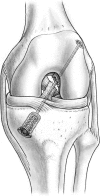Dynamic intraligamentary stabilization: novel technique for preserving the ruptured ACL
- PMID: 24651979
- PMCID: PMC4371814
- DOI: 10.1007/s00167-014-2949-x
Dynamic intraligamentary stabilization: novel technique for preserving the ruptured ACL
Abstract
Purpose: Replacement of the torn anterior cruciate ligament (ACL) with a transplant is today`s gold standard. A new technique for preserving and healing the torn ACL is presented.
Hypothesis: a dynamic intraligamentary stabilization (DIS) that provides continuous postinjury stability of the knee and ACL in combination with biological improvement of the healing environment [leucocyte- and platelet-rich fibrin (L-PRF) and microfracturing] should enable biomechanically stable ACL self-healing.
Methods: Ten sportive patients were treated by DIS employing an internal stabilizer to keep the unstable knee in a posterior translation, combined with microfracturing and platelet-rich fibrin induction at the rupture site to promote self-healing. Postoperative clinical [Tegner, Lysholm, International Knee Documentation Committee (IKDC), visual analogue scale patient satisfaction score] and radiological evaluation, as well as assessment of knee laxity was performed at 6 weeks, 3, 6, 12, and 24 months.
Results: One patient had a re-rupture 5 months postoperative and was hence excluded from further follow-ups. The other nine patients presented the following outcomes at 24 months: median Lysholm score of 100; IKDC score of 98 (97-100); median Tegner score of 6 (range 9-5); anterior translation difference of 1.4 mm (-1 to 3 mm); median satisfaction score of 9.8 (9-10). MRI showed scarring and continuity of the ligament in all patients.
Conclusions: DIS combined with microfracturing and L-PRF resulted in stable clinical and radiological healing of the torn ACL in all but one patient of this first series. They attained normal knee scores, reported excellent satisfaction and could return to their previous levels of sporting activity.
Level of evidence: Case series with no comparison group, Level IV.
Figures
References
-
- Arnoczky SP. Anatomy of the anterior cruciate ligament. Clin Orthop Relat Res. 1983;172:19–25. - PubMed
-
- Barrett DS. Proprioception and function after anterior cruciate reconstruction. J Bone Jt Surg Br. 1991;73(5):833–837. - PubMed
-
- Beard DJ, Kyberd PJ, Fergusson CM, Dodd CA. Proprioception after rupture of the anterior cruciate ligament. An objective indication of the need for surgery? J Bone Jt Surg Br. 1993;75(2):311–315. - PubMed
Publication types
MeSH terms
LinkOut - more resources
Full Text Sources
Other Literature Sources
Medical
Research Materials



